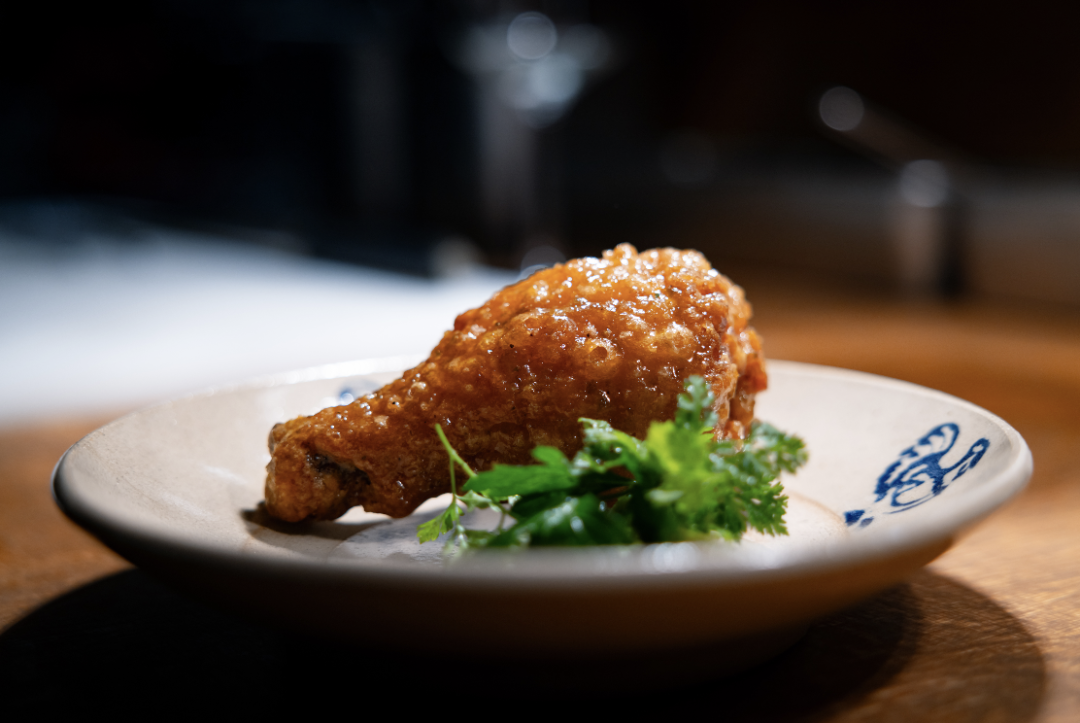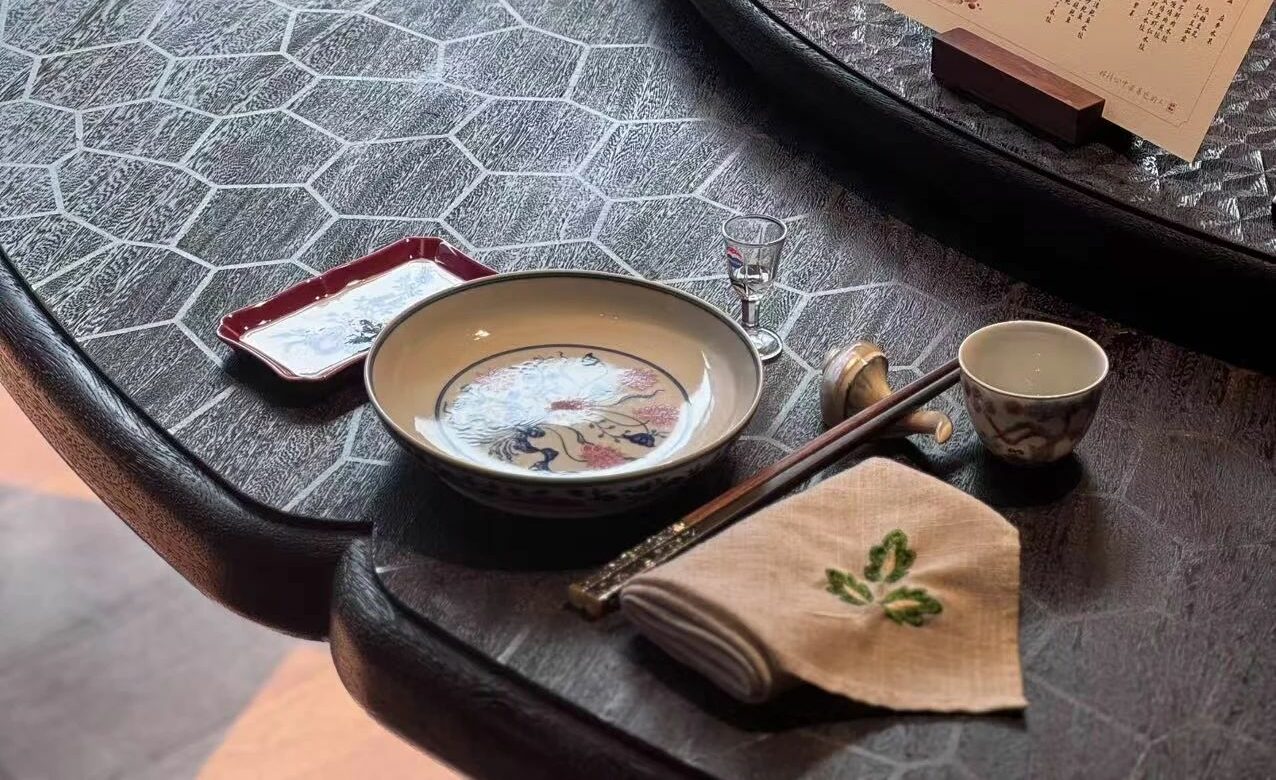Aside from R.O.W.T., which was mentioned in the previous article, another restaurant frequently cited by chefs in my “Where Do Chefs Eat?” segment is Sage. Sage has become one of the most popular restaurants in Shanghai this year, drawing significant attention. Its signature dish, the triple-crispy fried chicken leg, has attracted countless diners. The restaurant’s popularity is evident as they need to turn tables twice each evening. If you want to book a spot within a week, it’s often fully booked. It’s best to reserve at least a week in advance. As someone with an unpredictable schedule, I’ve already failed three times to make last-minute bookings.(相關閱讀:2024: A Look at Shanghai’s Restaurants Risen Against the Tide
Chef Jun Nishiyama, originally from Singapore, has a unique background that shapes his distinctive culinary perspective. Although his mother is Japanese and his father is Singaporean, Jun was born and raised in Singapore, which he considers his true home. “I am 100% Singaporean,” he proudly says.
@Jocelyn華姐的TastyTrip YouTube
In 2008, Chef Jun began his career at Singapore’s renowned Tippling Club, where he spent eight valuable years honing his skills and developing a deep understanding of innovative cuisine. After leaving Tippling Club, Chef Jun sought to broaden his culinary horizons in Europe. He worked for about six months at the three-Michelin-starred Geranium in Copenhagen. Later, he was invited to join Paul Pairet’s Ultraviolet, an avant-garde, immersive three-Michelin-starred restaurant. Over six years, Chef Jun rose to senior sous chef, contributing to the restaurant’s unique and unforgettable dishes.
 Chef Jun Nishiyama
Chef Jun Nishiyama
In 2022, Chef Jun took a bold step in his career by opening his first restaurant, Sage Gastro, near Suzhou Creek in Shanghai. The small “hall” has only six tightly packed tables, resembling a cozy bistro. The kitchen also features a chef’s table seating 5-6 guests, though diners must use the restroom at a neighboring restaurant—a small compromise for the freedom of entrepreneurship. Sage reflects Jun’s deep-rooted humble culinary philosophy. His cooking emphasizes simplicity and the use of local ingredients. “I avoid using luxury items like caviar, foie gras, or truffles,” he explains. His goal is to create delicious dishes from everyday ingredients, challenging himself while staying true to the essence of food.
Sage Gastro offers a range of modern, creative dishes inspired by Chef Jun’s personal experiences and love for cooking. For instance, the appetizer Kingfish Tartare blends citrus zest, green asparagus, and finger lime. This dish features lightly cured hamachi seasoned with yogurt, fermented citrus, and finger lime, served with charred asparagus, and drizzled with seaweed oil. The freshness of the ingredients and delicate seasoning elevate this dish to a level typically found in fine dining restaurants. However, the charm here is that you don’t have to endure lengthy tasting menus, and the prices are relatively more accessible.
Another standout dish is the Thrice Fried Drumstick. As the name suggests, the chicken leg is fried three times using a different batter and temperature, resulting in a crispy exterior and tender interior. It’s served with a fermented tamarind sauce and fresh herbs, giving the fried chicken a refreshing twist. Jun says the concept for this dish was inspired by Karaage (Japanese fried chicken). While many diners love this dish, Sage’s high proportion of standout dishes ensures that this isn’t the only reason to return.
 Thrice Fried Drumstick
Thrice Fried Drumstick
Other menu highlights include Beef Tartare with leek sprouts and hazelnuts, and Charred Hispi Cabbage with mushroom-flavored fermented cream, Italian parsley, and roasted buckwheat. Each dish reflects Jun’s strong culinary background and his determination to elevate simple ingredients to new heights. One heartwarming dish is the Potato Gnocchi. This dish combines marinated grilled maitake mushrooms, potato foam, and rich roasted chicken jus. Made from potatoes, butter, and flour, the gnocchi is lightly fried in brown butter and drizzled with chicken jus, accompanied by egg yolk mayonnaise, roasted walnuts, parsley, and corn puree, and topped with a sprinkle of salted egg yolk. It’s both indulgent and delightful.

The desserts are as refined as expected, such as the Sour Cream Ice Cream served with grapes, wine syrup, and rosemary oil. The inspiration for this dish came from Jun’s visit to a vineyard in Shandong, where the abundance of grapes and rosemary sparked his idea to combine these two uncommon flavors into a refreshing and unique dessert.
Nowadays, many small restaurants claim to be “Bistronomy,” but they may not realize that many bistros offering pre-prepared dishes don’t deserve the title. Eating casually doesn’t mean eating carelessly.
“Bistronomy,” a term combining “bistro” and “gastronomy,” originated in Paris in the 1990s and represents a culinary revolution that merges the relaxed atmosphere of bistros with the refined techniques of haute cuisine. Young chefs left top restaurants, rejecting expensive formalities and opening their small eateries, offering creative dishes at affordable prices. This movement spread rapidly and became a global trend, making “Bistronomy” a key symbol of contemporary cuisine.
Sage Gastro champions a humble approach to cooking, reminding us that the simplest ingredients can often produce the most profound flavors. This is the true spirit of Bistronomy.
Another Hot Spot in Shanghai: La Bourriche 133 – A Modern Seafood Grill Specializing in Basque Open Fire Grilling
What exactly is Basque open-fire grilling? It’s a style of cooking that focuses on grilling local ingredients over an open flame to highlight their natural flavors.
When I first returned to Shanghai, I had intended to stick to Chinese cuisine for the first week. However, on a Friday evening, I went to La Bourriche 133 with colleagues, and the restaurant was already packed. The atmosphere was intense, with diners clearly there for the food. Thankfully, this wasn’t just another trendy spot for photos, at least not that night.
Upon entering, I noticed that all the seafood in the display windows was transported fresh on ice. I wasn’t particularly excited about the opening sea urchin caviar dish, but the plumpDalian sea urchin, with its distinct mango fragrance, caught my attention. No surprise, as the restaurant is part of Jia Rui’s chain, known for its strong supply chain management, ensuring high-quality ingredients.

One dish that stood out was the Mackerel Pâté created by executive chef Li Jiawei. The yellow element on the dish was smoked chicken oil, topped with red Sichuan peppercorns. I was impressed by the fine texture of the fish, which was cleanly prepared without any fishy taste. The sunflower chicken oil added depth to the flavor, while the peppercorns on top brought a lively, vibrant touch—truly outstanding.
The whole grilled sole was fresh, juicy, and tender, with perfectly crisped skin. The fish was expertly filleted into neat squares, with a unique smoky aroma and dried chili adding layers of flavor that made each bite addictive.
Another highlight was the rose rock lobster. The lobster was perfectly cooked with a slightly runny center. The sauce, made from buffalo milk whey, was light and refreshing. I rarely order lobster, as it’s often overcooked, but here the temperature control was spot-on, resulting in tender, juicy meat.
Li Jiawei, born in Singapore, grew up in a family steeped in over 60 years of hawker culture, with a strong foundation in traditional Teochew cuisine. In 2012, he trained at Le Cordon Bleu in Sydney and completed internships at Les Amis and Andre in Singapore during school breaks.
Upon returning to Singapore, Li left his corporate job to join the opening team of Odette, where he worked under Julien Royer for three years, gaining a deep understanding of modern French cuisine. He then moved to the Waldorf Astoria Maldives Ithaafushi to work at The Ledge, where he honed his open-fire cooking skills under Dave Pynt, the head chef of the Michelin-starred barbecue restaurant Burnt Ends. It’s no surprise that he’s now offering a new modern seafood dining experience.
Basque open-fire grilling has become increasingly popular in Europe. However, some food enthusiasts believe that once you leave the Basque region, the barbecue is no longer authentic, as they argue that it’s all about the local ingredients. Interestingly, at the world’s second-ranked Basque barbecue restaurant, Asador Etxebarri, most of the ingredients come from the Basque region, but the famous Prawns of Palamós are sourced from the Catalonian coast—a compromise the chef made for quality.
Li explained that when they first introduced Basque open-fire grilling, the style was very authentic, with large amounts of olive oil, but many customers couldn’t accept it. To ease their concerns about the “oiliness,” he emulsified the olive oil with fish broth, creating his own modern seafood barbecue style. Since the menu is entirely seafood, I would compare it to the Basque seafood grill restaurant Elkano.
Li’s background in French cuisine and his love for French sauces contrasts with the raw flavor concept of Basque grilling, which I find intriguing. However, every dish is delicately prepared, and even the additional sauces are light and precisely balanced. For example, the grilled octopus leg is paired with miso sauce, adding an oriental touch. This “smuggling” of sauce into the dish enhances the flavors and adds Li’s unique style to it. This is truly a reflection of the chef’s individuality. Open-fire grilling is spreading globally like wildfire; although it may seem rough, controlling the heat is challenging, and this style of grilling is where finesse emerges from the rugged technique.

Though the meal wasn’t inexpensive, it was certainly worth the price. Given the quality of the ingredients, the pricing felt fair.
In my previous article, a reader asked if there were any common traits among these thriving restaurants. I have to say that while the answer may seem intangible, the key factor is simply that the food is delicious (laughs). These restaurants use high-quality ingredients without inflating prices, seat fewer than 50 guests, and have talented chefs at the helm. Doesn’t that sound like the business model of many chef-owned restaurants in Japan?
According to 2024 data, Japan has over 1,000 Michelin-starred restaurants, which highlights Japan’s importance in the global culinary scene. In contrast, there are over 300 Michelin-starred restaurants in mainland China.
After all, the Michelin Guide entered mainland China much later, with a nine-year gap compared to Japan. Of course, this isn’t a fair comparison, but today, we are benchmarking against a Japan that has weathered the aftermath of its economic bubble. Even in the wake of the pandemic’s advantages, there is still vast potential for restaurants in mainland China—if more cities are willing to sponsor them (laughs). Many Michelin-starred Chinese restaurants must offer à la carte options alongside tasting menus, which presents its own challenges. Restaurants like Tou Zao (头灶) in Shanghai, which operate on low fixed costs, provide us with some inspiration. However, the key is that they must be fully booked every day. Looking back at some of Japan’s most difficult-to-book restaurants, many gained fame after years of offering great value.
Whether it’s a restaurant or a chef, they must return to the fundamentals of the F&B industry: how to give guests an unforgettable dining experience. The three restaurants mentioned in this article have all achieved that. Is it just the pandemic’s windfall, or do they truly care more about customer satisfaction than awards? The question of whether a restaurant can be run successfully has become secondary.
Although there’s been plenty of negative news in the restaurant industry this year, such as owners disappearing overnight, many great restaurants continue to open their doors fearlessly.
Despite the tough economic conditions in China, humanity’s need for food and socializing remains strong. AI won’t replace that anytime soon, so let’s cherish these moments while we can.
Author: Jocelyn 华姐









